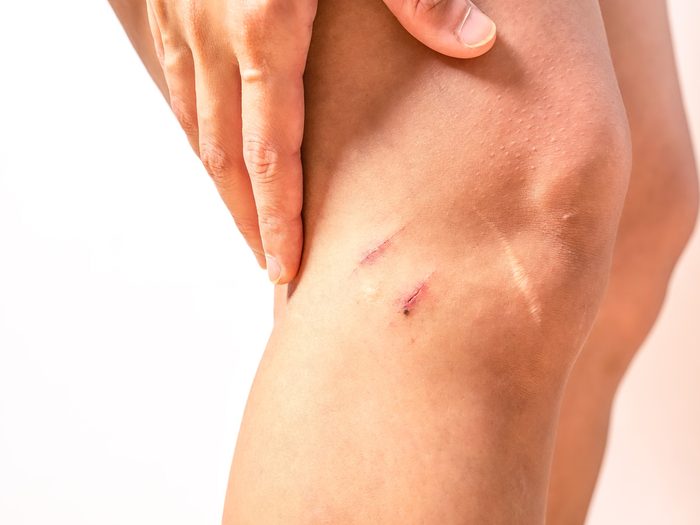
There are particles still stuck in your skin
Depending on the circumstance that caused your scrape, such as falling on gritty pavement, it’s possible that small particles could have gotten lodged in the affected area. It’s critical to remove any particles or dirt from your wound immediately, during the cleansing process, according to Sonoa Au, MD, of Advanced Dermatology, P.C. in New York and New Jersey, or you could have an infected cut. “However,” she adds, “if you find that you have to dig at your skin to get rid of anything that’s stuck, see a doctor instead.” Don’t assume that scrubbing away at your skin is helpful or that dirt will work its way out. When in doubt, have a medical professional thoroughly clean and assess your scrape or cut.
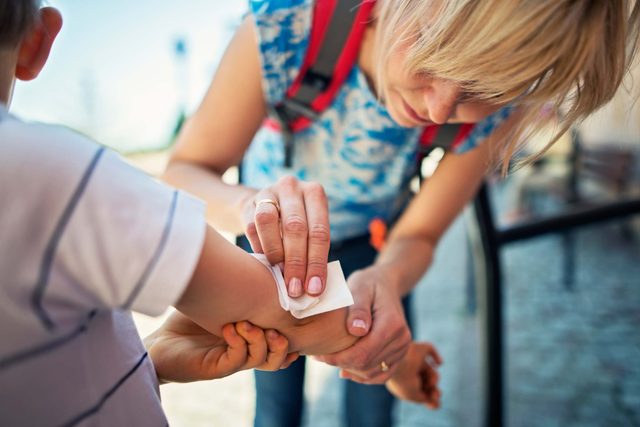
You used soap to clean your scrape
Surprised to see soap on the list? Regular hand soap can sometimes irritate skin, which may stall the healing process and in turn, lead to an infected cut. Of course, the way everyone reacts to various cleansers differs from one person to the next, but why take the chance when tending to your cut or scrape? The best bet is for you to refrain from using harsh ingredients. “Use a gentle cleanser like Cetaphil to clean the area,” Dr. Au suggests. And here’s what you should know about hand sanitizers.
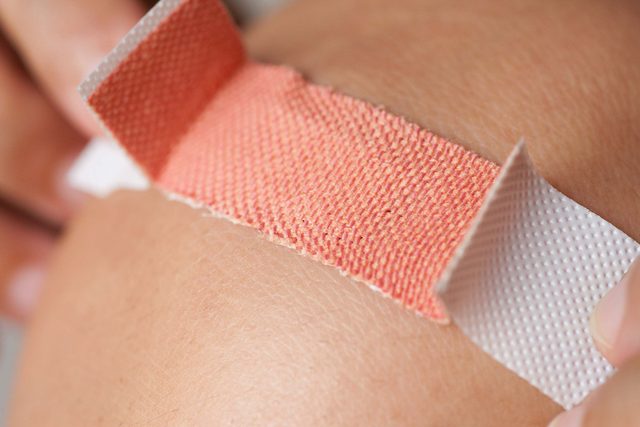
You skipped the bandage
If you think it’s a good idea to let your skin “breathe” after cleaning out a cut or scrape, think again. Dr. Au explains that exposing your skin this way has infection written all over it. “New cells have to migrate to the appropriate areas to help with healing,” Dr. Au explains. “Keeping your scrape covered and moist facilitates this process. Exposing wounds to air does not.” The best way to get on the fast track to healing and help prevent infection is to keep the wound hydrated with ointments like Neosporin, Vaseline, or Aquaphor. Looking for more? Check out our first-aid primer on how to care for wounds, fever, sprains and breaks.
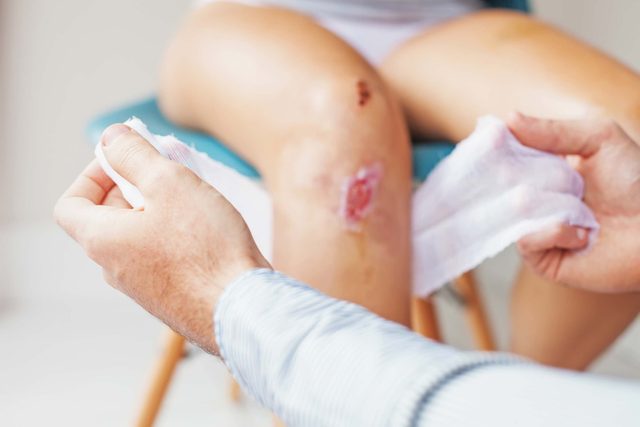
Your cut is very deep or was caused by rusty metal
Getting a deep wound in general—especially one caused by rusty metal—doesn’t guarantee that you’ll develop an infected cut, but it does mean you should seek medical attention immediately. Don’t try to resolve these kinds of cuts or scrapes on your own at home. Dr. Au is adamant about seeing a doctor in these instances because you’ll likely need stitches or at least additional attention above and beyond at-home application of Vaseline and a bandage. Here’s what your skin can reveal about your health.
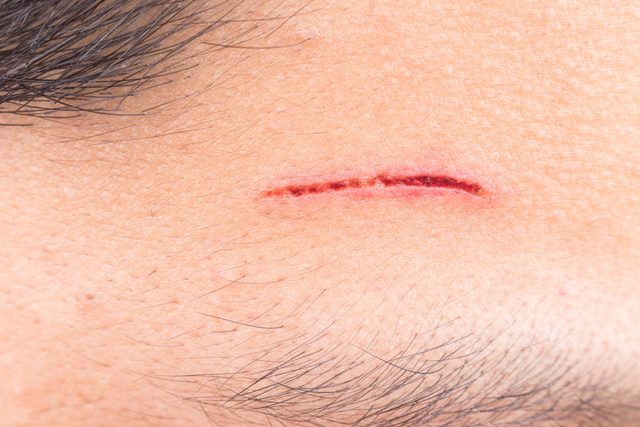
Redness around the affected area persists
It’s perfectly normal for skin around the cut or scrape to look different for a while: Redness, some pain, and even the appearance of tissue that’s commonly confused for pus (more on that later) is often par for the course. The warning sign to watch for, according to Dr. Au, is when any of these symptoms seem to get worse rather than better. Redness around a cut or scrape is a sign of healing, for example. But when that colour persists or spreads significantly, it may have become infected. See your doctor ASAP.

Your pain doesn’t subside
Obviously, cuts and scrapes hurt a little—some hurt a lot. But if your pain lingers to a point that seems abnormal or intensifies instead of gradually improving, then Dr. Au says it’s time to reach out to your doctor about a possible infection.
Wondering about that lump on your skin? Here’s, we explain the most common skin mysteries like lumps, bumps, boils and more.
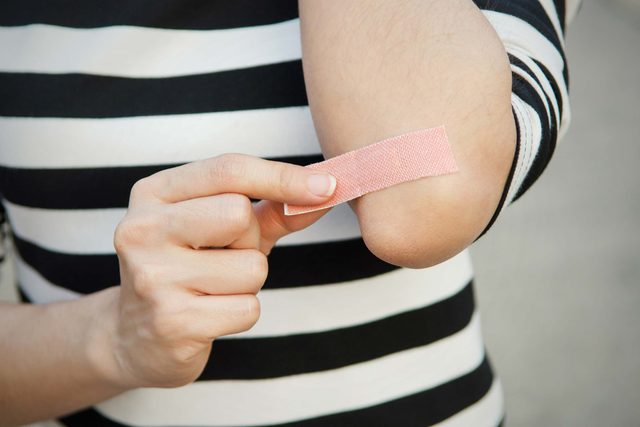
The pus is smelly or green
Two things to look out for if you develop pus after getting a cut or scrape: colour and odour. If you observe pus that’s green and/or foul-smelling, that’s a surefire sign of an infected cut that should have you dialing your doctor. But a yellow-ish substance on your cut or scrape? No need to worry. Dr. Au says that what you’re seeing, in that case, is actually something called granulation tissue, which is a part of the healing process and shouldn’t be confused with pus. Don’t miss these health clues your hands are trying to tell you.

You feel ill
Although it seems like signs of a skin infection would be confined to your skin, that’s not always the case. As infection spreads, your body mounts a stronger counter-attack—and that can cause systemic symptoms such as fever, nausea, mental confusion, or just feeling out of sorts. While everyone is different if you feel bad after a lingering wound, head to a doctor for an assessment of your skin and symptoms. Your infected cut could be getting more serious.

When your infection becomes something more serious
Skin infections can escalate into a grave threat, and it can happen literally overnight. Staph infections are one example. According to the Mayo Clinic, these infections are brought on by staphylococcus bacteria, germs that are typically found on the skin of healthy people. They’re usually not problematic; it’s when the bacteria invade your body that a staph infection can turn deadly by creating toxicity in your bloodstream. One of the kinds of infections caused by staph bacteria is cellulitis, which is marked by redness, swelling, sores, or areas that ooze a discharge—typically confined to the feet and lower legs. Impetigo is another skin infection brought on by staph bacteria. It’s a contagious, painful rash that typically results in large blisters along with an oozing fluid and an amber-coloured crust. Be sure to see your doctor if you have any of these symptoms or suspect your infection has taken a turn for the worse. He or she may prescribe antibiotics or drain areas of your skin to help improve your condition. Next, learn which Canadian provinces have the longest emergency room wait times.
